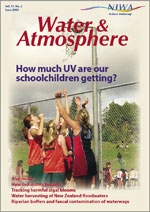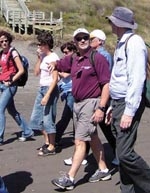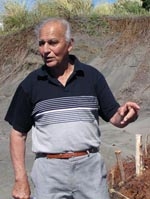PDF of this article (324 KB)

Courses at NIWA
Managing coastal hazards



On a sparkling day in March, a small crowd of regional council staff, planners, and engineers took an educational stroll along Raglan’s Wainui Beach. The field trip to Raglan was a highlight of a two-day course held in Hamilton by the NIWA/GNS Natural Hazards Centre. The participants were there to see for themselves the possible effects of storm and high tides on a west coast beach.
There were stops along the beach for mini-lectures on the nature and habits of waves and sand, and to see examples of beach erosion and accretion. Near the harbour entrance, the party met Raglan locals Tex Rickard and Angeline Greensill, who demonstrated the success beach-care activities have had rebuilding beach and dune defences using branch-and-brush fascines and dune planting.
Back in Hamilton, the course provided one and a half days of seminars, all geared to the needs of regional councils and resource managers. Topics included: coastal erosion and inundation, effects of climate change, coastal mitigation options, and the realities and challenges of managing coastal hazards. The talks were punctuated with small-group exercises that gave the participants hands-on experience with problems such as predicting storm surge and extreme tides.
For further information, contact: Doug Ramsay, 0-7-859 1894, [email protected]
Marine habitat mapping

NIWA’s new National Centre for Coasts & Oceans staged its inaugural marine habitat mapping course in Wellington in March. The two-day course drew 25 participants from a variety of organisations including MFish, Department of Conservation, Ministry for the Environment, Maritime Safety Authority, MAF Biosecurity, Seafood Industry Council, regional councils, environmental consultants, and coastal iwi.
NIWA staff presented the latest technology and science in mapping and interpretation of seafloor habitat and environment. They showed how these have been applied around New Zealand with real examples, including:
- subtidal and estuarine habitat mapping near Auckland to establish the effects of urban development
- nearshore mapping to identify areas for aquaculture, marine reserves, or sand extraction
- possible impact of bottom-trawling on seafloor environments
- deepsea mapping of submarine volcanoes with their unique ecosystems.
The presentations also showed the value of baseline monitoring to establish the effects of human activities, especially in coastal environments. Throughout the course, speakers demonstrated the important link between the physical environment and the biological environment.
The National Centre for Coasts & Oceans plans to repeat the course early in 2006.
For further information, contact: Dr Ian Wright, 0-4-386 0322, [email protected]
Stream Team at the Manukau Home & Garden Show

What do you prefer your neighbourhood stream to look like? This is the question we put to the visitors to the Home & Garden Show in Manukau, Auckland, the last weekend in April. The aim was to gather opinions about the types of streams people would like to see in their neighbourhoods by asking them to rank a set of photographs of urban streams from most appealing to least appealing. The results of the survey will be used in guiding research into stream restoration and will be published in an article in a later issue of Water & Atmosphere.
The event was a great chance to talk to a wide cross section of the public and we were pleased to find that about a tenth of visitors to the show filled out the form. To encourage participation in the survey, we put all the completed forms into a draw for a basket of goodies plus a NIWA cap and umbrella. The lucky winner was Lyn Gibbs of Pakuranga.
The Stream Team ran a similar survey about farm streams at the Mystery Creek Fieldays in 2002 and you can see the results in “Do people like riparian management on farm streams?”.
For further information, contact: Dr Stephanie Parkyn, 0-7-856 0786, [email protected]
New books
Restoring streams for freshwater fish
by Jody Richardson and Ian Jowett, NIWA Science and Technology Series No. 53. 55 p.

How can I improve my stream to make it more inviting for freshwater fish?
This new guide provides an overview of things to consider when restoring streams for freshwater fish communities. People undertake stream restoration projects for a variety of reasons, such as to stabilise banks, improve water quality, or enhance biodiversity. These activities are not necessarily mutually exclusive, and you can often achieve supplementary objectives by including other relatively simple activities.
In the book, we discuss twelve commonly occurring fish communities and their environments. Location and stream morphology are two of the most important determinants of fish community composition. Other key features include access, water quality, cover, and catchment landuse. If restoration projects are to succeed, they must enhance the appropriate physical features for the most likely fish community. We describe the important physical features associated with each fish community to help you design the most appropriate plan for restoring your stream. We also include results from an active restoration project, highlighting some valuable lessons.
The guide is available from this website as a free downloadable PDF file.
Or you can purchase a copy for $30 by printing and sending an order form to Science Communication, NIWA, Private Bag 14901, Wellington, [email protected]
Using statistical methods for water quality management: Issues, problems and solutions
by Graham B. McBride, Wiley. 344 p. ISBN 0-471-47016-3

Written by a NIWA scientist with many years of experience in water science and management, this book will help water resource managers and scientists to formulate, implement, and interpret more effective methods of water quality management.
McBride lays the foundation for using statistical methods in water resource management, including some rapid calculation procedures, and then builds on that with a series of practical problems and solutions on a range of frequently met environmental topics. These include:
- formulating water quality standards
- determining compliance with standards
- MPNs and microbiology
- water-related, human-health risk modelling
- trends, impacts, concordance, and detection limits.
To promote awareness of alternative approaches to analysing data, McBride contrasts statistical methods in terms of their applicability to various environmental issues. The book encourages discussion between technical staff and management before embarking on statistical studies.
Available from booksellers, the book can also be ordered online from the publisher at www.wiley.com
For further information, contact: Graham McBride, 0-7-856 1726, [email protected]
